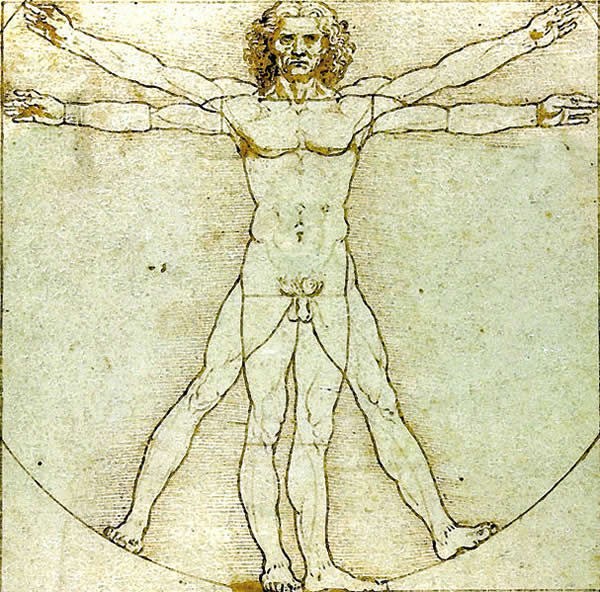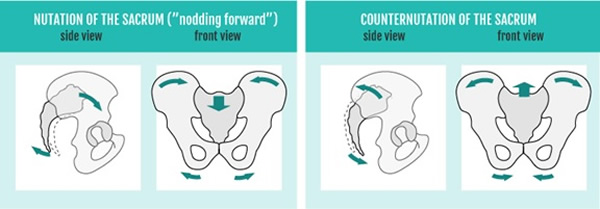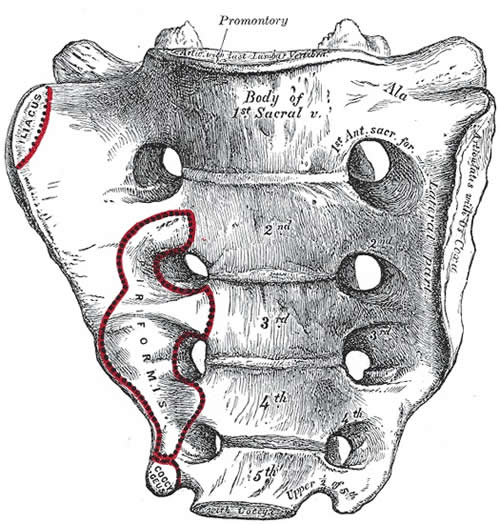Positive Health Online
Your Country

The Sacrum - Anatomy of its Structure and Energy
by David Lauterstein(more info)
listed in anatomy and physiology, originally published in issue 259 - January 2020
Basic Anatomy of the Spine
- 7 cervical vertebrae (by the way, giraffes have seven too – but each about 10” long and the joints between those are ball and socket);
- 12 thoracic vertebrae – (each except for the bottom two, articulating with ribs on both sides);
- 5 lumbar vertebrae;
- 5 vertebrae in the sacrum (don’t fully fuse until as late as 26!);
- 3-5 vertebrae in the coccyx (fully fused by 30) (this is as much tail as we get to have – the pangolin in West Africa has 49 coccygeal vertebrae comprising its tail!).
The spine is naturally curved. The curves of spine enable us to support 10 times the weight than if it were straight. We are born in kyphosis – the primary curve is exemplified in the foetal position. It is concave anteriorly, in the womb we are kind of rolled into a ball. The secondary curves, are lordoses - involving concavity posteriorly. These develop in the neck and lower back as we learn first to lift our heads and later to walk upright.
Vertebral facets
- The facets which articulate between the thoracic vertebrae face each other front-to-back (in the “coronal plane”) – so they allow rotation (limited some by the ribs and sternum);
- The articular facets between the lumbar vertebrae face each other side-to-side (in the “sagittal plane”) – so they are very limited in rotation but do allow for flexion and extension. Nature has limited rotation between the lumbar vertebrae so that the weight of the upper body is supported with more stability by the lower back;
- The 12th thoracic or 1st lumbar is the center of what is sometimes referred to as the “lumbo-dorsal hinge”. The 12th thoracic vertebra is the unusual, transitional vertebra between the thoracic and lumbar spine. It has upper facets in the coronal plane but its lower facets are in the sagittal plane;
- Because the lumbars run right into each others’ facets, rotational forces are severely limited in here. Rotational forces wind up affecting the joints immediately above and below – i.e. the lumbodorsal hinge area or the sacro-iliac joint.
Etymology
The sacrum’s etymology reveals very special beliefs connected to the sacrum in many cultures from ancient times on. “Sacrum” comes from the Latin os sacrum meaning "sacred bone, “os” being bone" and “sacer”, sacred. The belief is that the soul resides in the sacrum. We will return to the sacred aspect later as we explore the energetic theories attending to the sacrum.
Sacrum in the Center
When standing, the center of gravity in the human body is normally located in front of your sacrum, at about the second sacral level.
The sacrum is associated with the “hara” – this is identified as the one’s center in meditative practices and often associated with the center not only of one’s physical body but of the energetic body as well.
Hub of a wheel – That the sacrum is at the center of the person is classically illustrated in the famous Vitruvian man by Leonardo Da Vinci which shows the sacrum at the center from which the limbs extend like the spokes of a wheel.

Courtesy Wikipedia
Sacrum as Structural Pivot
The sacrum and its joint with the ilia of the pelvis play perhaps the most important and most pivotal role in the body’s structure because the sacrum is the transitional bone which transmits the force and energy of the entire upper body from the axial system (associated with the cranium, spine and ribs and sternum), into the appendicular system of the pelvis and lower limbs. Unlike the shoulder girdle in which the scapulae are free to move, in the pelvic girdle the ala (etymologically “wings”!) of the pelvis are tightly bound to the sacrum via the short sacro-iliac ligaments, giving us the stability we need to stand and move with security. The actual joint between the sacrum and the ilia (the upper bones of the pelvis) is a strong, yet still synovial joint (containing a small amount of synovial fluid) which allows to slight gliding movement and it has in the joint irregular elevations and depressions that produce some interlocking of the two bones.
Sacred Arch
“Irene Dowd in “Taking Root to Fly” likens the sacrum to a keystone arch in a church. The downward force of the arch keeps the columns in place. Of course in the body the columns are our legs and far more subtlety is needed to adjust to the constant micro movements we make even when we are still. Add to that the 19 ligaments in and around the pelvis plus the 57 muscles that have a connection to the pelvis and you have a cross over area where there is a translation of the heaven to earth forces…the sense of the spine connecting from the sacrum up to the brain and the doorway to allowing our grounding forces to flow.”
Jeff Lennard, Zero Balancing Teacher
Foundation Joints
Foundation joints are special joints in the body that are not primarily freely moving or “diarthrotic” joints such as the elbow, knee, hip, etc. Foundation joints are quite stable. They have NO muscles running from one involved bone to the other. They play the role of transmitting energy and force through our bodies, primarily through the center. The sacro-iliac joint is, with those in the feet, the most important foundation joint in the body. No muscle runs from the sacrum to the pelvis, so we have very limited movement there – but it is completely critical as the central place of stability in our whole body.

Courtesy Sequence Wiz and Mai Town Yoga
Movements of the Sacrum
Nutation and counter nutation - these are the names for the movements at the sacro-iliac joint. Nutation (same root word as “nod”) is the sacrum tipping forward and down. Counter-nutation is the tucking under of the sacrum, the top goes backward and the coccyx goes forward.
Some of the muscles responsible for nutation include the erector spinae, multifidus, and adductor magnus and some of the counter-nutating muscles include pectineus, adductor longus and brevis, piriformis, and coccygeus.
Sacrum in the Cranio-sacral System
The sacrum is identified as the lower pole of cranio-sacral system – as the name cranio-sacral implies. The spinal cord itself ends about L1 or 2. However the nerves continue in the spinal canal, no longer as a cord, but as the bundle of nerves collectively called the “cauda equina”, or “horse’s tail”.
Sacrum – Occipital bone connection - known as the “Lovett Brothers” chiropractic theory. This proposes a link between the upper and lower vertebrae. The sacrum is supposedly linked with the occipital bone, the coccyx with the sphenoid, L5 with C1 and so forth.
Energetics of Sacrum
5 fused vertebra constitute the sacrum. In Chinese medicine and Zero Balancing the belief is that the deepest, densest energy charges flows through the deepest, densest structure – the bones. The sacrum being five fused vertebrae holds therefore the highest energy charge. This may account for the strong hold that the second chakra (associated with the region of the sacrum) has on us! In Sanskrit this chakra is called “Svadhistana” - associated with water, excitement, species creativity (contributing to birth)
- Indian and Chinese Perspectives
From the area of the sacrum arises, according to Indian philosophy, the kundalini energy – energy that travels up the spine and can be amplified through various movement and spiritual practices. The sacrum is therefore considered not only the lower pole of the cranial system but also of the kundalini energy. - Bladder Meridian – according to Chinese medicine the bladder meridian runs near the sacral foramina (Bladder 27-35) and the “Du” governing vessel (GV 2 & 3)l running near the spinous processes of the sacrum.
- 8 winds and the foramina - - "In Chinese acupuncture traditions the eight sacral foramina (the paired holes at each level of the sacrum) are sometimes known as the eight winds. These can be taken as vents through which the vital breaths of qi and spirit blow, as well as ability to orient to the eight directions (the sacrum in relation to the centre of gravity). This latter allows us to embody pivotal balance so we can adapt and be free to be open to all possibilities."
– Alan Hext, UK Acupuncture and Zero Balancing teacher. - Myofascial Foundations – just as the foundation joints are designed more for energy and structural transmission, so are foundation myofascial layers. These are basically diaphragms that are organized transversely through the body which pass substance and energy through them and are used more for support than primarily for locomotion:
- The arches of the feet;
- The pelvic floor (to which the sacrum is tied through fascia and muscle);
- The intestinal and esophageal sphincters;
- The heart valves;
- The larynx;
- Mouth
- Eyes (sphincters for light!);
- Ears
- Crown of head
Obviously among these are myofascial correlates of the chakras.
Essential Muscles Affecting the Spine and Sacrum:
Anterior
- Rectus abdominis;
- External and internal obliques;
- Transversus abdominis;
- Psoas and iliacus;
- Diaphragm.
Posterior
- Erector spinae;
- Multifidus;
- Quadratus lumborum;
- Gluteus maximus;
- Piriformis;
- Coccygeus.

Courtesy Wikipedia
Muscles which Attach to the Sacrum Itself:
Anterior Surface
- Piriformis: Originates from S2 – S4 level of the pelvic surface. Due to its attachment at the trochanter of the femur, it is able to externally rotate, abduct, extend and stabilize the hip joint;
- Coccygeus muscle inserts on the lower sacrum. It gives support to the contents of the pelvic cavity and due to its attachment to the coccyx, is able to flex (counter-nutate) the bone;
- Iliacus – although it primarily arises from the iliac fossa, it also has fibres originating at the ala of the sacrum. Its distal attachment to the lesser trochanter of the femur allows it to flex the thigh at the hips and stabilize the hip joint.
Posterior Surface
- Multifidus lumborum – the deepest muscle arising from the sacrum. Some of its fibres cover the upper two sacral foramina. This muscle attaches to the transverse processes of the superior vertebrae and is therefore able to help stabilize the spine;
- Erector spinae – partly arises from the posterior sacrum and the sacrospinous ligament. It is essential in achieving extension and lateral bending of the head and vertebral column.
Sacral Fascia
The sacrum is not only the originating area for our energy, it is also the place of “insertion” for the structure of our back, both in terms of bones, muscles and fascia. On the most extensive layers of fascia extends from the lumbar area all the way down the sacrum. This is the “thoraco-lumbar fascia”. It is diamond shaped with the bottom ending on the sacrum and coccyx and continuing as the fascia connecting the sacrum and the bottom of the pelvis via the “sacrotuberous” ligament. That ligament ends where the hamstrings begin and its fascia then is continuous with the fasciae of the back of the hip, thigh, and lower leg.
Sacro-Iliac Ligaments
Ligaments and sprain - The ligaments that span the sacro-iliac joint need just the right "span." Too close and too loose, they become less healthy as tissues. So when we sit on our pelvis all day, the pelvis is pressed up into the sacrum, closing this important distance; the ligaments lose their appropriate span; they go slack. The next time you bend over suddenly without being warmed up, there is a greater chance your back will spasm. This is because the nervous system, reading the Si ligaments as less reliable, will spasm your lower back to assure stability. Thus, the importance of doing things such as yoga to open up the SI as well to strengthen the core muscles.
Awareness and Health Through Movement
Two exercises that help bring more life and health to the sacrum and pelvis:
- Pelvic clock -The Pelvic Clock is a subtle exercise that mobilizes the sacrum and lower back in a very gentle, yet multi-dimensional way. Imagine that there is a clock lying flat on your lower abdomen. Twelve o'clock is at your belly button, 6 o'clock is at the top of your pubic bone. Your hip bones are at 9 and 3. You engage your abdominals to move the pelvis only an inch or so in each direction. The goal is to do this movement smoothly with the abs and not the back. You isolate the movement of the pelvis so that the upper body stays still and relaxed and the hip sockets allow the pelvis to move without affecting the legs. Use this exercise to build awareness of positioning your abs, pelvis, and spine.
- Kegels / Mula Bandha – Toning the pelvic floor muscles: gently contract the muscles of your pelvic floor. This can feel like you are drawing your coccyx toward the public bone. An easy way to begin feeling this is to inhale and hold your breath, then pinch the nostrils and attempt to suck in air. The suction then mobilizes the pelvic floor. These are the same muscles we use to temporarily stop urination.
Having felt those muscles clearly, then let go of the nostrils and breath holding, and just contract the pelvic floor muscles.
Try it holding for 3 seconds, then relax for a count of three. To maximize the benefit, repeat three times a day with 3 sets of 10-15 repetitions total.
Kegels help with pelvic health generally and are particularly indicated for urinary incontinence.
All this structural information and energetic lore with respect to the sacrum, whether it all is factual or in some cases speculative, nonetheless give us a much deeper appreciation for the role that this, the sacred bone, plays in the life of our structure and our energy. May we treasure and bring a heightened awareness to this fascinating part of us!
Comments:
-
No Article Comments available